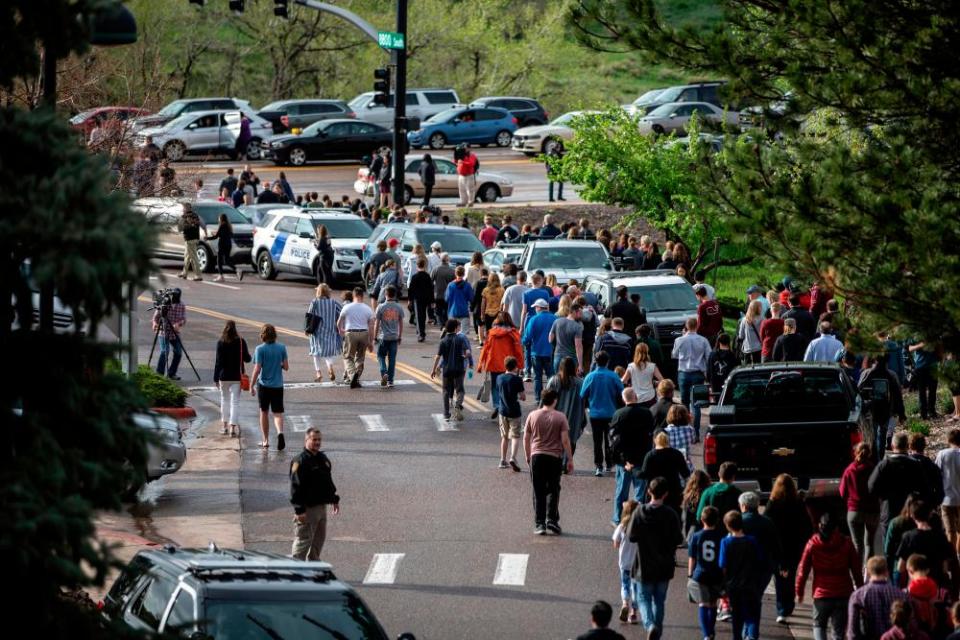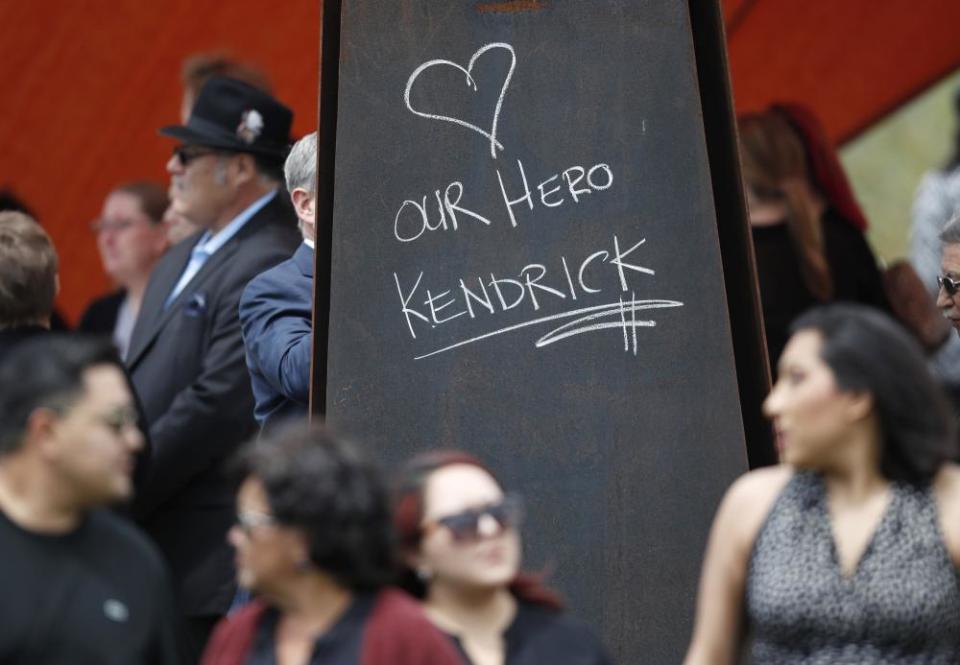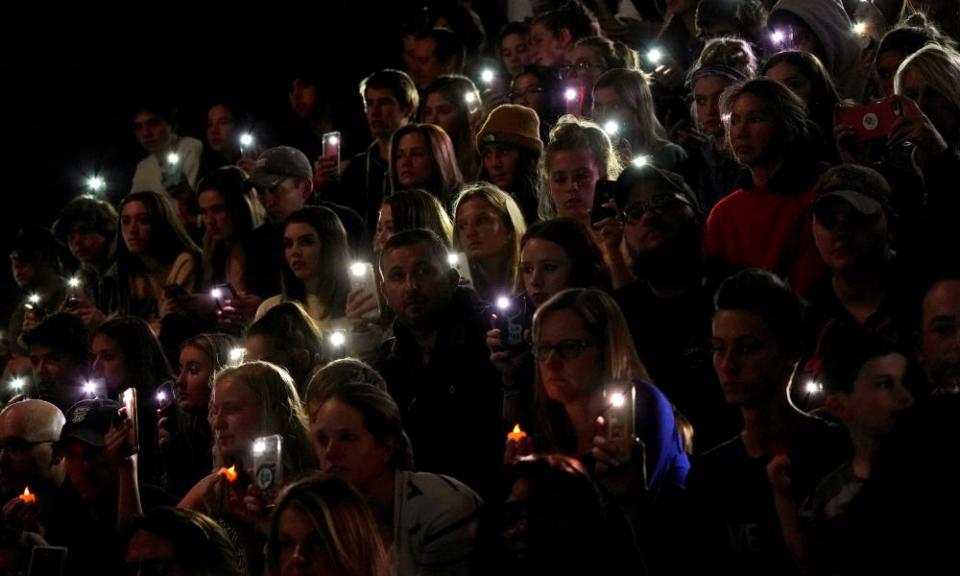'Why is this happening?' Colorado reckons with another school shooting

Two little girls played in the grass outside Stem School Highlands Ranch in Douglas County, Colorado, where a school shooting took place on 7 May. The girls’ parents solemnly looked over a shrine. Flowers, teddy bears and a six-pack of Coca-Cola had been laid under a photo of the school’s hero, 18-year-old Kendrick Castillo, who was killed while tackling one of two student shooters.
Related: Columbine at 20: how school shootings became 'part of the American psyche'
Eight students were injured; due perhaps to his action, Castillo was the only fatality. Next to his portrait, cardboard letters spelled out “#STEMSTRONG” and someone had written in colored chalk on the sidewalk “You’re SO loved”, next to Castillo’s yearbook quote: “The most difficult roads lead to the most beautiful places.”
“They don’t know anyone got hurt,” Michelle Watts said of her daughters, aged six and eight, who laughed as they raced round the shrine. Stem has 1,850 students in kindergarten through 12th grade. “They think it was a drill. They’re young enough to where I feel like I’m going to leave it at that until they ask the right questions, because it breaks my heart.”
The attack was the 15th school shooting this year in the US, according to CNN. It took place eight miles away from Columbine high school, patient zero in an epidemic that has provoked copycat shooters as well as threats there as recently last month, on the massacre’s 20th anniversary.
In 2012, the Denver metro area also suffered one of the deadliest mass shootings in modern US history, when a gunman in an Aurora, Colorado, movie theater killed 12 and injured 70.
A recent analysis by the Denver Post found that since 1999, metro Denver has seen more school shootings per million people than the 24 other largest US metropolitan areas, and the third-most mass shootings by population.

Students being evacuated after the shooting in early May.Photograph: Chet Strange/AFP/Getty Images
Residents are understandably fearful, sad and confused.
“Since this happened, I went down the Columbine rabbit hole and the Sandy Hook rabbit hole. I felt like I needed to know why this stuff is happening,” said Watts. “It doesn’t make any sense to me. I don’t know how to keep my children safe.” She said she had little hope for tighter gun laws but relayed the community’s wish that metal detectors at least be installed in all schools.
If anything seemed certain, it was that the anxiety, grief, and trauma would not dissipate anytime soon.
“What am I going to do?” Watts said. “Put my girls in some other school and then have it happen again?.”
It was ninth period, a 12th-grade British literature class and the teacher had just put on the movie The Princess Bride. A student came in late, went to the front of the room and brandished a handgun. He said, “Nobody move,” witnesses recalled.
The first person to react was Castillo, who lunged from his desk and slammed the gunman against the wall. Two of Castillo’s friends, Josh Jones and Brendan Bialy, followed his lead as gunshots rang out and classmates hid under desks or ran to the door. Jones was shot twice in the leg as he brought the alleged shooter, Devon Erickson, down to the floor. Bialy wrenched the gun away. Castillo was unresponsive. When a teacher came to help, Bialy pumped his friend’s chest. A security guard came in and restrained Erickson until police arrived.
The Douglas county sheriff’s office has not released details about the second alleged shooter, Alec McKinney, 16, nor about the suspects’ motivations. Both students were arrested within 14 minutes of the first 911 call and each has been arraigned on more than 30 charges, including first degree murder.
In a press conference days after the shooting, Bialy gushed about his late friend, “a fantastic and wholesome person” who “died a legend”.
When asked why they confronted the gunman, Bialy said: “I don’t like the idea of running and hiding. Why in the world would I let this coward get what he wants?” He added: “I refuse to be a victim. Kendrick refused to be a victim.”
Castillo has been lionized for his valor, remembered as a kind, generous classmate, and honored in gatherings that celebrated his love of Jeeps, hunting, fishing and robotics. He intended to study engineering at nearby Arapahoe Community College in the fall, and was killed just days before graduation. Castillo’s loss was mourned at that event as well as through public vigils and a celebration of his life attended by 2,000 people.
Local and national press has focused on the heroes, while little attention has been devoted to the alleged shooters. Students avoid their names during interviews. And news outlets in Denver have taken pains to use the suspects’ images sparingly in response to the “No Notoriety” campaign, a metro Denver-based movement that asks media to limit coverage of shooters’ identities to avoid inspiring copycats or others who seek infamy.

The funeral of Kendrick Castillo, who was killed while trying to stop a gunman in his school.Photograph: David Zalubowski/AP
Psychologists laud such efforts but some fear that in the process, journalists risk glorifying heroic interventions in a way that encourages people to take dangerous risks. There is also the danger, some say, of exacerbating the guilt some survivors feel for having followed active shooter protocols that suggest students run and hide, to avoid complicating the law enforcement response. Typically, engaging a shooter is recommended only as a last resort, to be taken verbally if possible.
“Without question, these young people acted selflessly and helped to save lives. They deserve to be honored and remembered. However, we caution against unintentionally glamourizing the extremely high risk of confronting an armed assailant head on, particularly when it involves youth,” read a statement by the National Association of School Psychologists in response to the Stem school coverage.
Steven Berkowitz, a visiting psychiatry professor at the University of Colorado, believes that since adults have failed to respond to the school-shooting problem, children and young adults are increasingly taking it upon themselves. Young people, and particularly children, are more likely to behave without considering consequences and to harbor hero fantasies, he noted.
“Now you have kids who already are feeling some survivor guilt and the message is, if you want attention, you want support, you want love … act heroically, which flies in the face of what they’re taught,” said Berkowitz. “Now that everybody’s done a very good job of not talking too much about the perpetrators, there’s a news void, and part of this emphasis on the heroes is due to that.”
Kendrick Castillo’s father, John Castillo, might agree. He told the Denver Post he wished his son had hidden. In an interview with NBC News, he also recalled that the two once spoke hypothetically about active shooter scenarios. He told his son: “You don’t have to be the hero.”
On the night after the shooting, a vigil took place in a neighboring high school gymnasium. Stem school students filled bleachers, mourning their classmate for the first time as a group. The event was hosted by gun control advocates, some of them Stem students, and featured politicians such as the Democratic senator and presidential candidate Michael Bennet, who upset many in the audience when he invoked a need to “fix broken gun laws”. One person stood to say, “Let Stem kids speak.”
Organizers had badly misjudged the timing, if not also the fervor, for a focus on gun control. Angered students chanted “mental health” and walked out in droves to hold impromptu tributes to Castillo in the hall. Lifting cellphone lights in the air, some shared stories about their friend while decrying the perceived effort to use their grief as a “political prop”.

A moment of silence during a vigil for the victims.Photograph: Rick Wilking/Reuters
The vigil was reorganized to bring in student voices, but it still left many furious. Fischer Argosino, a junior at the school, wrote in an op-ed: “Kendrick was loved by many, and to disrespect his memory with selfish intent was something we did not have the stomach for. He was a human being, not a statistic ... How the vigil was conducted only proves that politicians are too far removed from the situation to even help us.”
Argosino said Stem students planned to engage in political advocacy but that everyone he’d spoken to wanted to focus on mental health, because “gun control is way too controversial” and “divisive”. This was also in response to the facts of the crime, he acknowledged: the shooters used handguns, not semiautomatic rifles, and reportedly stole the weapons from a parent, making it hard to envision a gun policy reform that would have prevented the event.
Argosino also said the older shooter had a difficult home life and was bullied at times for his small stature, yet never exhibited violent tendencies or other warning signs.
“He seemed like any other normal kid,” explained Argosino. “That’s why it’s really weird to process something like this. I would consider myself his friend. We’d talk in the hallways and joke around about normal things. I never once got the idea that he would do anything like this.”

